Although the economy was improving in 1935 and bank failures were abating, the Federal Reserve System was thrown into turmoil that year by the passage of the Banking Act of 1935. The law fundamentally reshaped the structure, the personnel, and some of the principles of the Federal Reserve System created in 1914. It redirected the history of the System, including the Federal Reserve Bank of Atlanta. This legislation represented the largely successful effort by Marriner Eccles, Roosevelt's second appointment to the helm of the Federal Reserve, to reconstruct the System as a more centralized public policy institution. Instead of a confederation of regional banks providing liquidity as needed on a regional basis, Eccles reshaped the Fed to pursue a uniform set of macroeconomic goals for the nation.
Perhaps most significantly, the 1935 law finalized a movement toward a centralized mechanism for national monetary policy that had begun in the 1920s.
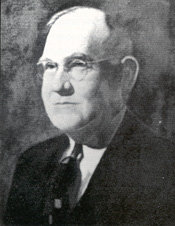 Oscar Newton, appointed in 1934, was the first person to be called "president" of the Federal Reserve Bank of Atlanta. |
At first, each Reserve Bank had the power to conduct open market operations—the buying and selling of Treasury securities on the secondary market—for its own account. Initially Reserve Banks had used these to augment their own, often flagging, income from rediscounting to help finance operating expenses. Increasingly, however, the power of these activities to influence the growth of the nation's supply of money and credit and thus the pace of economic activity came to be understood. By the 1930s the value of a single open market strategy conducted in concert by the Board and the governors of the 12 District Banks was acknowledged. The 1935 law created the Federal Open Market Committee (FOMC), composed of the seven members of the Federal Reserve Board and the District Bank governors. Four of the governors would rotate as voting members of the committee. They were no longer called "governors," however. Under the new system, each Federal Reserve Bank would have a president, recognized as its chief executive officer, and the title of governor would be reserved for members of the Washington Board, now called the Board of Governors. The title of the head of the Federal Reserve Board was changed from governor to chairman.
The law set the terms of all sitting members of the Federal Reserve Board to end on February 3, 1936, giving President Roosevelt the chance to do with the Federal Reserve Board what he wanted to do with the Supreme Court: reconstitute it with his own appointments. Only two members of the Board were not replaced in 1936—Eccles and another Roosevelt appointment, M.S. Szymczak. Those who "retired" in 1936 included original 1914 appointees Charles S. Hamlin and Adolph C. Miller.
On the District Bank level, the office of chairman and Federal Reserve agent was changed from an executive position to one with general oversight responsibilities. Federal Reserve agent duties were largely delegated to Bank staff. This controversial move brought the immediate resignations of six of the Reserve Bank chairmen, some of them major powers in the System.
All Bank governors younger than 65 were eligible for reappointment as presidents but now subject to approval by the Board of Governors. The Board did not approve efforts to reappoint elderly presidents in Philadelphia, Richmond, and San Francisco, evidence of what Time magazine for March 16, 1936, called "the Board's wholesale housecleaning." However, the 59 year-old Newton was approved as the first president for the Atlanta Bank. Three officers in Atlanta were terminated in 1936 as having passed retirement age, among them cashier M.W. Bell.
The Fed expands its role
The "New Deal architects" had "remodeled the Federal Reserve System into what for all practical purposes is a central bank of issue under political control," Time declared. The transformation was denounced by H. Parker Willis, an architect of the original system, as "the most highly centralized and irresponsible financial and banking machine of which the modern world holds record." The pressures to end the Depression and the energies of New Deal planning undid the delicately decentralized arrangement of 1914. The feuding that had marked much of the System's first 21 years largely disappeared after 1935. The Fed chairman was far from a dictator, and collegial decision making became the hallmark of the new system. But where the Board agreed to go, the System followed after 1936.
The Fed was redesigned to play a larger role in directing the national economy. "[W]ithout the Federal Reserve the New Deal would have been impossible," writes Elgin Groseclose in America's Money Machine: The Story of the Federal Reserve (Arlington House, 1980). "Monetary management was the core and the motor of the New Deal. The Federal Reserve provided the mechanism by which money was managed." Essentially, the FOMC could seek to encourage growth in the economy by increasing banking system reserves through net purchases of government securities. If the economy appeared to be overheating, the committee could reverse the process and, by selling from its portfolio, restrict the growth of money and credit. Eccles, an ardent if unread Keynesian, first attracted the attention of FDR's brain trust with his theories that the country was suffering from inadequate demand for goods and services and that the federal Treasury and the banking system should provide enough money to assure demand, which would feed production and jump-start the economy.
In wanting to concentrate control and use the System as an instrument for carrying out public policy for the nation's economic welfare, Eccles was in step with his New Deal colleagues. What was wrong with the old Federal Reserve System, in their view, was not that it was too democratic or too banker-dominated but that it didn't work. Its regional orientation was inadequate to bring the country out of its paralysis. If bright, forceful, public-spirited leaders could focus potentially powerful measures like open market operations and use them to energize the economy, Congress was willing to let them try.
The 1936 reconstruction of the Federal Reserve System introduced a culture that favored younger, better-educated officers with management skills over seasoned operations pros steeped in the nitty-gritty procedures of the System. As emphasis shifted from providing liquidity at the regional level to stabilizing the national economy, the old banking skills—particularly credit skills—declined in importance, and the need for knowledge of economics increased. Growing complexity in the regulation of the commercial financial services industry placed a premium on understanding law. And as electronic payments entered the picture, the Federal Reserve System would seek engineers, computer scientists, and executives with strong management skills.
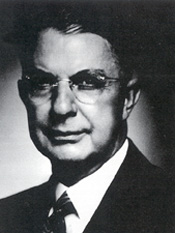 Frank H. Neely, chairman of the board of directors from 1938 to 1953. |
Frank Neely takes charge
The forces of change crystallized in the Sixth District with the appointment of Frank H. Neely to a three-year term as a Class C director, starting January 1, 1937. Neely became chairman a year later and was very much the commander of the Federal Reserve Bank of Atlanta until System policies forced him to retire at the end of 1953. Neely was a mechanical engineer from the Georgia School of Technology (now the Georgia Institute of Technology) who pursued enlightened management as something of an engineering problem to be solved with rational organization, operating efficiency, minimal waste, and no duplication of effort.
He was also a forceful and highly competent executive. Neely ran things. First he ran the Fulton Bag and Cotton Mills, an industrial challenge. Then he ran Rich's department stores, one of the city's largest retail operations. Even though Rich's was a family business and Neely was not family, he ran it, first in fact and then in name as well. He ran local government, civic, and charitable organizations too numerous to mention. And in his spare time he experimented with scientific agriculture on his Norcross farm and wrote books like The Manager, A Human Engineer.
And Neely ran the Federal Reserve Bank of Atlanta for 16 years. Four Bank presidents answered to him during his long tenure. The presidents were by law the chief executives of the Bank, and Neely happily let them manage the details of daily administration. But on broader policy questions they all answered to Neely, who made it clear that he expected the Bank to be efficient, progressive, and productive, and that no one would be asleep at the switch.
One officer who worked closely with Neely, Malcolm Bryan, later reminded him of "the days in 1938 and 1939 when you were prowling the institution from cellar to garret and asking all of the pertinent questions that appealed to your orderly and experienced mind about the flow of work, the equipment, the layout of the shop—and, in passing, making ungracious but pertinent fun of the broken-down adding machines, over-age typewriters, and bedraggled and inefficient equipment generally."
Neely spent considerable time in his chairman's office at the Bank, where he frequently held long and sometimes animated meetings with whomever was president. All the presidents became quite familiar with his prodding. Other staff members had little contact with him and regarded him as severe and a little frightening.
Actually, Neely knew very well what the 1935 act had done to his office and his Bank and what Eccles was tying to do with the System. Moreover, he generally supported these objectives. He would have been more impatient with the old decentralized System. It suited him to be a volunteer chairman instead of a professional staff member, and his own agenda for shaking up the Atlanta Fed dovetailed reasonably well with Eccles's agenda for the System.
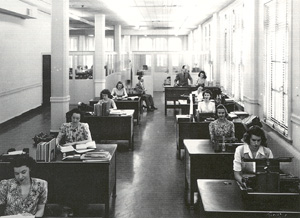 The Bank's research department in the 1940s. |
The rise of research
At the top of Neely's agenda was attracting a top-notch economist to the Atlanta Bank and establishing a strong research department. That was where the future lay, he shrewdly concluded after he saw the ambitious plans in Washington for turning the System into a powerful agency for conducting monetary policy. The Board in Washington and the New York Bank already were starting to build research departments. Economists would be needed and heeded. Neely went right to work on the problem. In June 1937 he told the Atlanta board that they needed to hire a recognized economist. In July he told them that he had been to Washington to confer with E.A. Goldenweiser, the Board's chief economist, and that Malcolm Bryan was the man to hire. Bryan, born in Illinois and trained as a graduate student at the University of Chicago, had been professor of economics at the University of Georgia since 1925. He was a popular lecturer, an eloquent communicator, and a sophisticated and possibly brilliant economist. The Board of Governors already had "discovered" him and brought him to Washington to work on special projects, on a leave of absence from the university, when Neely learned about him.
In January 1938, just after he was named chairman of the Atlanta Bank, Neely wrote to the Board in Washington, proposing to start a research and statistics department in Atlanta and to hire Bryan to manage it. Eccles approved, and Bryan was hired as vice president at a salary of $7,500.
The Bank always had compiled certain statistics of commercial interest—commodity prices, department store sales, and so forth—and published the data in printed monthly reports. Feeding such information to the Board staff in Washington was part of the Federal Reserve agent's job, but this work had never been considered a primary function of the Bank. In 1921, when Chairman McCord had proposed starting a Bank library, Governor Wellborn had stocked it with edifying fiction for the clerical staff. But 1938 was a different matter. Economic data and analysis were needed to support and direct the kind of economic management the Board was attempting. To meet the demand, Bryan organized a true research library and hired a librarian. In the Bank's Monthly Review, the old statistical compilations of routine commercial data were compressed to make room for more analytic, scholarly reports. By 1942 the research department had a staff of six.
Slow days in a stagnant economy
Even with ambitious intentions and supportive research, the Fed found the economy balky and difficult to manage through the 1930s. The modest recovery that began in 1933 continued until a recession in 1937 wrecked the fragile progress. The banking system, once the wave of bank closings and liquidations had passed, was a reservoir of largely unused capacity. Reserves rose to unprecedented levels, leaving banks ready to lend to borrowers who never showed up. It was not surprising, therefore, that member banks rarely asked the Fed for credit. Rediscounts, in Atlanta as elsewhere, were rare, even when the rediscount rate dropped to an all-time low of 1.5 percent in 1937, well below 1920's record high of 7 percent. The government securities on which the Bank largely depended for income now were held in a pooled account managed at the System level. Like their members, the Reserve Banks sat on a mountain of excess reserves. Excess reserves posed problems for the Washington architects of the new monetary policy because they insulated the banks from any actions the Fed could take. The Fed was figuratively in the driver's seat of a stalled car. It may have held the steering wheel, but unless the car would move it could not be directed.
Operations, in Atlanta and other District cities, were flat. There simply was little to do, and, with depressed earnings, the Bank tried to take in sail and operate as economically as possible. Employees who left often were not replaced. When home-office cashier M.W. Bell retired, President Newton told the board that a new cashier was unnecessary, that other officers could handle his duties. (By statute, the cashier was custodian of all monies, investments, and securities; in practice he was a general manager of asset and liability activities at the Bank.) Director J.A. McCray, chairman of the building committee since 1916, recommended disbanding that committee since it had no foreseeable work to do.
The changeover to a more centralized system left bruised feelings among many of the District Bank directors and officers, who did not like to see local authority reduced. Resentment surfaced at an April 1940 meeting of Reserve Bank chairmen at Sea Island, Georgia. The chairmen, Neely reported, said that they felt unimportant now that the Washington Board, rather than the local board, was making the policies and directing the operations of District Banks. The Washington staff was overbearing in issuing new rules and regulations, the Bank chairmen complained. Governor Ronald Ransom, a former Atlanta banker, conceded that Reserve Bank operations had become largely mechanical, but he urged the Banks to emphasize research and become important sources of business and economic information.
A succession of presidents
A series of uncontrollable circumstances forced management changes at the Atlanta Fed and prevented it from falling into step with the new orientation of the System as quickly as Neely probably would have liked. Bryan may have been Neely's farsighted idea of the new breed of Reserve Bank president, but Neely had to wait 13 years to bring his plan to fruition, as untimely deaths forced sudden management changes. Oscar Newton certainly was no new-breed central banker. Like McCord, Wellborn, Black, and Johns, his roots were in commercial banking, and he had been drafted into a Reserve Bank dominated by credit and operations concerns. The winds of change scarcely had begun to blow, however, when, on February 10, 1939, reportedly in the midst of a board meeting, Newton had a sudden heart attack and died three days later (having been "stricken at his post of duty," as the board's eulogy put it).
Within a week, the new president was 55-year-old Robert S. Parker, a lawyer whose prestigious firm (which included a descendent of Thomas Jefferson and a relative of Woodrow Wilson) had represented the Bank since it opened.
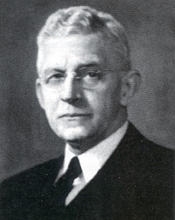 William S. McLarin, Jr., ascended to the Bank presidency in 1941 and remained in office until 1951. |
Parker was a Phi Beta Kappa graduate of Emory University and the University of Georgia law school. His legal work for the Bank expanded until, in 1930, he left his law firm to become the Bank's first in-house general counsel. In 1936 he became the first officer to hold the title first vice president. He had a reputation for being conscientious and personable and seems to have worked smoothly with Neely and Bryan. To replace Parker as first vice president, the board promoted one of its three vice presidents, William S. McLarin, a veteran operations man.
Two years later, on March 28, 1941, Parker died. His unexpected early death created a leadership vacuum, and the board responded by promoting McLarin, a decision that would bring complications for the next 10 years.
A crusty insider takes the reins
If Parker was a relative outsider, having worked most of his life outside the Bank, McLarin was the ultimate insider. He took his first job, at age 17, as a runner for Atlanta National Bank. After several years in the collection department of the Atlanta Clearing House, he moved to the Federal Reserve Bank in 1916 as chief clerk, first in the transit department, then in the auditing department. During World War I he joined the Army and went to France, then rejoined the Bank. Considered a tenacious supervisor, McLarin was sent to Jacksonville as cashier at a time when that branch was suffering from weak management. He was circumspect enough to have made the trip to Cuba in 1926 without damaging his reputation. He returned to Atlanta in 1931 as assistant deputy governor. The deaths of Newton and then Parker created the vacancies which propelled him to the top.
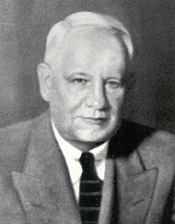 Robert S. Parker succeeded Oscar Newton and served as president from 1939 to 1941. |
McLarin was intimately familiar with the internal operations of the Bank and largely unfamiliar with the politics, business, and economics that went on outside its walls. Stories circulated long after his departure about how he would sweep a pile of books or papers off the top of a file cabinet if he thought they looked messy, or how he would put on a white glove and run his finger across file cabinets or desks to see if they were dusty. His manner may have been gruff, but veteran employees of the Bank discovered that he was intensely loyal to people he had worked with over the years and slow to terminate someone who was sick or struggling with personal problems. McLarin, good soldier that he was, took his marching orders from Neely, but he had his own ways and was out of step with much that Neely was trying to do in the Bank.
Bryan, who wanted to be president, was promoted to first vice president when McLarin vacated that post. A rivalry between McLarin and Bryan became evident to most of the senior officers, and Neely seemed to spend more time conferring with Bryan than with McLarin. The old guard hung on in the Atlanta Bank, however, and Bryan finally resigned after World War II to take a position with Trust Company of Georgia.
Neely had learned early that he would need to struggle with the old guard. In 1937 W.H. Kettig, an original director and deputy chairman of the Bank for many years, pushed through, over Neely's objections, a policy that denied employment at the Bank to a married woman whose husband could support her, and it terminated within three months any woman employee who married such a breadwinner. That policy, no doubt born of the scarcity of jobs during the Depression, was rescinded in April 1939 on the grounds that it "had operated in restraint of marriage."
Increasingly, however, Neely had his way. One area where his hand was felt was in the modernization of Bank facilities. Building activity froze after the burst of construction in the early 1920s. The Bank had adequate space in all locations until the 1940s, and there were meager earnings for remodeling. However, Neely inspected the buildings and pronounced them sorely in need of modernization. Air conditioning had become available by then, and the Jacksonville branch already had requested some units for its third floor. Under Neely's nudging, improvements, including air conditioning, were made to all buildings during 1937 and 1938. The "renovation and modernization" of the Atlanta headquarters were substantial enough to warrant a meeting of the combined Bank and branch boards with four members of the Board of Governors. At that meeting a resolution of commendation left little doubt as to who the prime mover was: "Mr. Neely was the enthusiastic, cheerful, and directing head from the inception of the movement. His exhaustive study of facts, his broad-minded approach to each problem as it arose, his skill as an inspired leader, combined to make him the man of the hour," one director asserted.
| Previous | Next |



